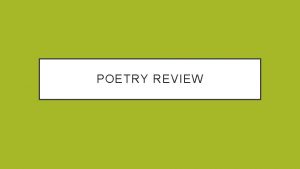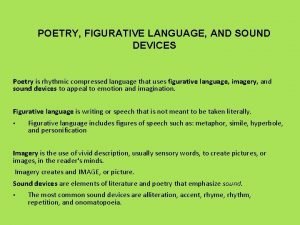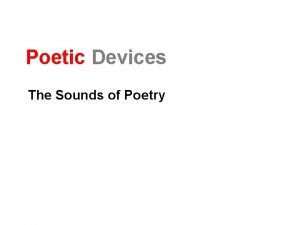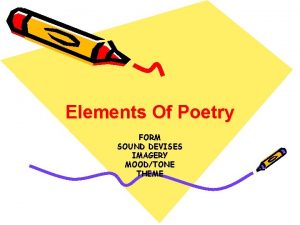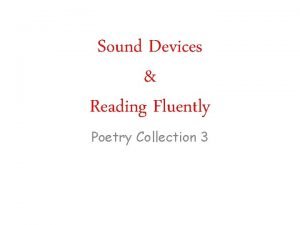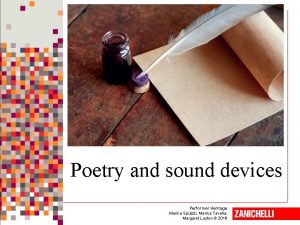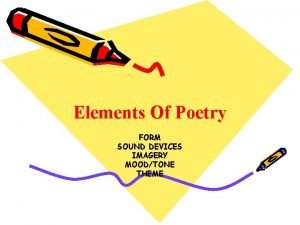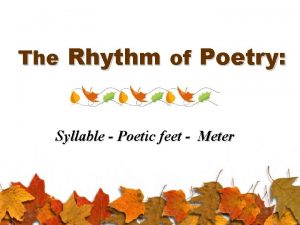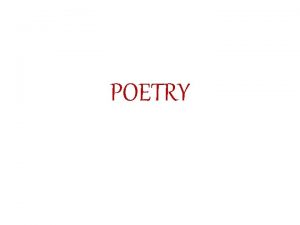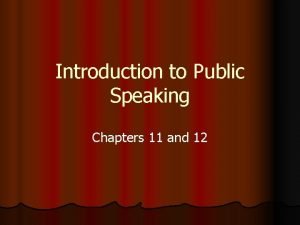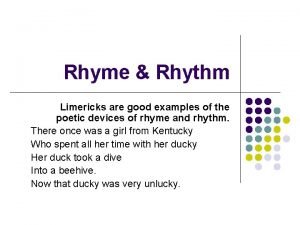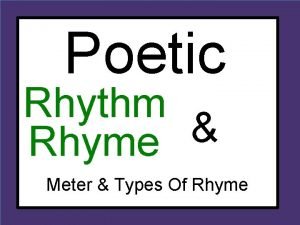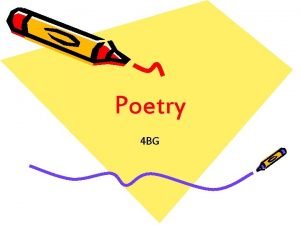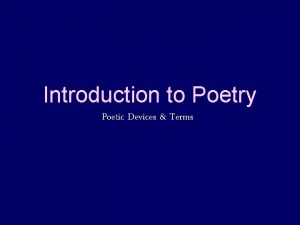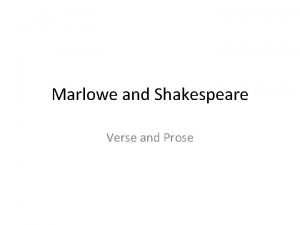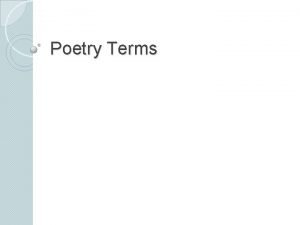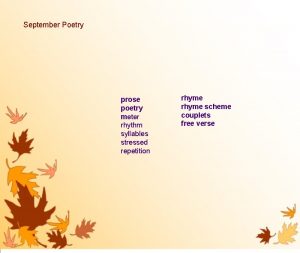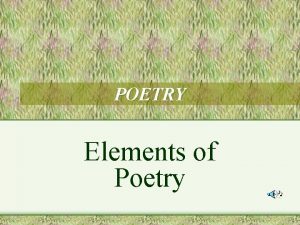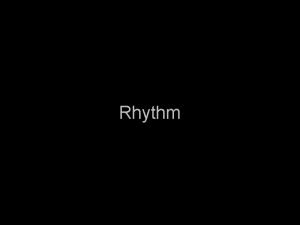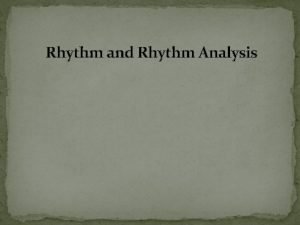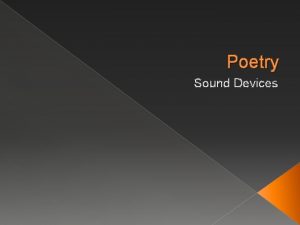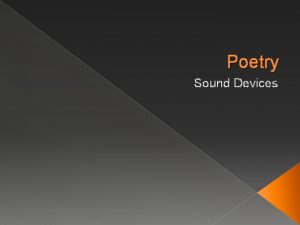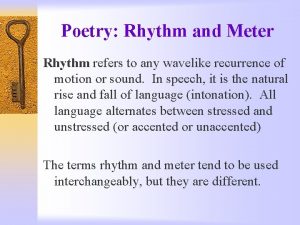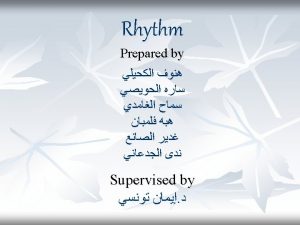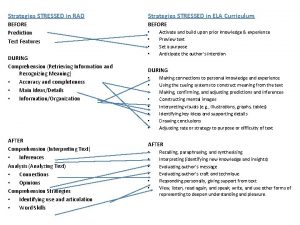POETRY SOUND DEVICES Rhythm the pattern of stressed

















- Slides: 17

POETRY

SOUND DEVICES • Rhythm – the pattern of stressed and unstressed syllables in each line • Meter – a regular pattern of rhythm – https: //www. youtube. com/watch? v=Ihz. Gjc 6 q. BWQ

• Repetition: a sound, word, phrase, or line that is repeated for emphasis and unity – I looked upon the rotting sea, And drew my eyes away; I looked upon the rotting deck, And there the dead men lay. ~from "Rime of the Ancient Mariner" by Coleridge

• Assonance: the repetition of vowel sounds in words that do not end with the same consonant • "Tune" and "June" are rhymes; "tune" and "food" are assonance – Example • "If I bleat when I speak it's because I just got. . . fleeced. "

• Consonance: the repetition of consonant sounds within and at the ends of words – Example “And black are the waters that sparkled so green. ” ~from “Seal Lullaby” by Rudyard Kipling

• Enjambment: The word Enjambment comes from the French word for "to straddle". Enjambment is the continuation of a sentence form one line or couplet into the next. Trees by Joyce Kilmer I think that I shall never see A poem lovely as a tree. A tree whose hungry mouth is prest Against the sweet earth's flowing breast; A tree that looks at God all day, And lifts her leafy arms to pray; A tree that may in summer wear A nest of robins in her hair; Upon whose bosom snow has lain; Who intimately lives with rain. Poems are made by fools like me, But only God can make a tree.

• Ballad A poem that tells a story similar to a folk tale or legend and often has a repeated refrain. – The Rime of the Ancient Mariner by Samuel Taylor Coleridge is an example of a ballad.

• Iambic pentameter A type of meter in poetry, in which there are five iambs to a line. (The prefix penta- means "five, " as in pentagon, a geometrical figure with five sides. Meter refers to rhythmic units. In a line of iambic pentameter, there are five rhythmic units that are iambs. ) Shakespeare's plays were written mostly in iambic pentameter, which is the most common type of meter in English poetry. – https: //www. youtube. com/watch? v=I 5 lsuy. UNu_4

• Blank verse Poetry that is written in unrhymed iambic pentameter. – Shakespeare wrote most of his plays in blank verse

• Limerick A light, humorous poem of five lines with the rhyme scheme of aabba Example: There once was a man from Peru (a) Who had a lot of growing up to do, (a) He’d ring a doorbell, (b) then run like hell, (b) Until the owner shot him with a. 22. (a) - Anonymous

• Lyric: A poem, such as a sonnet or an ode, that expresses the thoughts and feelings of the poet. A lyric poem may resemble a song in form or style.

• Sonnet: A lyric poem that is 14 lines long. – Italian (or Petrarchan) sonnets are divided into two quatrains and a six-line "sestet, " with the rhyme scheme abba cdecde (or cdcdcd). – English (or Shakespearean) sonnets are composed of three quatrains and a final couplet, with a rhyme scheme of abab cdcd efef gg. English sonnets are written generally in iambic pentameter. • “Shall I Compare Thee To a Summer’s Day” is a Shakespearean sonnet

• Free Verse: Poetry composed of either rhymed or unrhymed lines that have no set meter

• Parallelism: refers to the repetition of sentence structure or word order to achieve a rhythmical effect. • The word parallelism is derived from the word parallel, which refers to comparison of two elements that resemble each other, or things that have equal characteristics. • Therefore, parallelism in poetry involves the arrangement of coordinate thoughts to the effect that the relationship between them is emphasized and their meaning highlighted

Example: The children love their teacher, and the teachers love their children. Each morning we sing, each morning we dance, and each morning we pray. The birds are in their nests and in their nests they sing. • Note three things about the above example 1. The ideas expressed are nearly synonymous in meaning and are of equal force. 2. The expressions in parallel have the same tone, i. e. , they either both negative or positive. 3. The order of the words, or structure of the sentence parts is similar • This in essence is how parallelism in poetry occurs. Not only do the sentence parts ‘rhyme’, but the thoughts expressed therein also ‘rhyme’.

• From the poem you brought to class, begin to analysis process. Begin your intro with the following format:

Poetry Analysis Essay Outline • I. Introduction – A. Attention-getter (question, quote, fact) to lead into the subject of your essay – B. State TAG (title, author, genre) of poem you are analyzing – C. Briefly summarize the poem (speaker and situation) – D. Clear Thesis that names the key elements to be analyzed. Example “In 'Nothing Gold Can Stay', poet Robert Frost touches upon the beauty of things that are new and young, through use of natural imagery, metaphor and allusion.
 Sound devices used in poetry
Sound devices used in poetry Imagery and sound devices chart
Imagery and sound devices chart Onomatopoeia meaning in poetry
Onomatopoeia meaning in poetry Sound device assonance
Sound device assonance Mother to son
Mother to son Sound devices definition
Sound devices definition Poetry and sound devices zanichelli
Poetry and sound devices zanichelli Imagery in poems
Imagery in poems Examples of anapestic meter
Examples of anapestic meter It is the regular pattern of stressed and unstressed sounds
It is the regular pattern of stressed and unstressed sounds It is the systematic regularity in rhythm
It is the systematic regularity in rhythm The accepted standard of sound and rhythm is
The accepted standard of sound and rhythm is Rhythm vs rhyme
Rhythm vs rhyme Rhyme scheme
Rhyme scheme Meter definition poetry
Meter definition poetry The rhyme scheme is the
The rhyme scheme is the Poetic diction examples
Poetic diction examples Ordinary speech with no regular pattern of accentual rhythm
Ordinary speech with no regular pattern of accentual rhythm
